 |
|
 |
The name of the town Shintomi is derived from a playhouse called "Shintomi-za", one that was a large modern theatre in Tokyo during the Meiji Era. The town thrived as a theatrical quarter, where many Kabuki-related people lived. The town is strongly connected with traditional performing arts places even now, such as the Kabuki-za Theatre and Shinbashi Enbujo Theatre. In this town, there is a "Ono-ya Sohonten", a custom-made tabi (Japanese socks) shop, serving Kabuki actors such as Kankuro Nakamura and Ebizo Ichikawa, or classical Japanese dancers.
We introduce maestro Yasuo Fukushima, the 6th owner of the store in this month's feature. |
 |
 |
| History of tabi and the store |
 |
Our store was founded in the Edo-Ansei Era. We have been in business for more than 200 years in this place, and I am the 6th owner myself. We sell both custom-made tabi and ready-to-sell tabi. Our custom-made tabis are worn by Kabuki actors, classical Japanese dancers, Noh players, Japanese Tea houses, Enka singers, and all other kimono-clad people. We also offer ready-to-sell tabis in various sizes so that our customers are able to choose tabi that best fits their feet. We have a craft shop here, and we do the entire process of making tabi from sizing and sewing to finishing up.
|
|
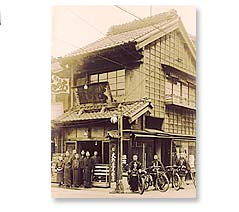 |
 |
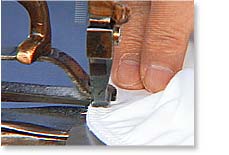 |
| "Shintomi-gata"style to make your feet look beautiful |
 |
Our "shintomi-gata" were created by my predecessor as a special shape and style of the store. We named the style after this town. It is said that toes are important in classical Japanese dance, so we make tabis by making the bottom part thin and giving the instep part extra room, so that the shape looks thin and beautiful on the stage. When we sew the tiptoe parts, we make many small pleats in order to hold the toes well. This requires the original skill of making the pleats so that the smaller ones are made first, gradually making bigger ones so they look like they are waving. Although it is difficult to attach three different pieces of cloth, the bottom, the left side, and the right side, to fit the foot comfortably without wrinkles, we try to provide tabis to best fit each customer by changing shapes slightly. A number of processes, from sizing to finishing up, are carefully done by master craftspeople. Delicate processes continues in various steps, such as attaching Kohaze hooks, sewing up the ankle part, and finishing the shape by hitting with a wooden hammer. Eleven of us, my wife, my son and his wife, skilled craftspeople, and myself, we all do these steps together.
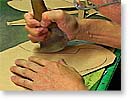 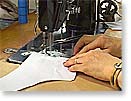 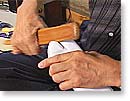
| 1.After sizing, make paper patterns to fit foot |
|
2.After cutting the paper,sew with sewing machine. Attach kohaze hook. |
|
3.Finish up by hitting with wooden hammer. |
|
|
|
 |
 |
| Technical Transmission (hand down the technique) |
 |
As I was born in this house, I naturally believeed in handing down the tabi shop business since I was a little. Special techniques were handed down to me by my father the predecessor, such as how to make paper patterns, and also how to sew with sewing machines by master craftpeople. Today, each craftsperson does his or her part only, expect for my wife and I who do all the processes specifically. We used to sew by hand, but after adopting sewing machines in the Taisho era, we have been following the same work style. Some of our sewing machines are hundreds of years old and they may break, so we even have spare machines in case of trouble. At our shop, we use "Wazarashi", as cotton best fits human skin color to suit kimonos.
|
|
|
 |
| Deep relationship with Kabuki and classical Japanese dance |
 |
As printed on our store wrapping paper, "When dancing, feet talk. When talking, eyes talk. When it comes to tabi, Onoya Sohonten" - we would like continue to produce "Shintomi-gata" tabis which makes dancing feet beautiful. We provide tabis to theaters like Kabuki-za each month, and hope actors can play well in their performances. In June this year, at the succession annnouncement stage of Ebizo Ichikawa, "Sukeroku yukari no Edozakura", I joined in the "Katobushi" chorus backstage, so I have interacted with actors directly this time, not indirectly through my tabi as I always do.
|
|
 |
 |
| "Shintomi-gata"tabi in this place |
 |
| We have been in business in this place since the second owner moved to this place. The current wooden house was built after the Great Kanto Earthquake and it survived the war. I can say this house is the history of Shintomicho. My personal history is with this place as well, as I was born here and went to school here. As there was a theater called "Shintomi theater", the town is historically related with Kabuki-za and Japanese dances. Our location is convenient for delivering tabis to those theaters. I would like to keep the tradition of "Shintomi-gata" tabi by cooperating with our very skilled crafstpeople. Fortunately, my son is taking over from me, so I hope for our store the best future. |
|
 |
 |
 |
 |
 |
| |
 |
|
 |
Onoya Sohonten
Custom-made tabi�i3,700 yen�j, tabi�ifrom 3,000 yen�jcolorful tabis, fortune-bringing tabis (1000 yen) and others are available. Various sizes of ready-made tabis are also available. You can find tabis to comfortably fit your foot there. Also, underwear for kimono, gauze pajamas, Chinese zodiac wash cloths (from 400 yen) hand illustrated by maestro. Fukushima and other classical Japanese accessories are also available. Even beginners to tabi can enjoy finding some there. |
 |
Address : 2-2-1 Shintomi, Chuo-ku
Phone : 03-3551-0896
Office hours : 9:00�`17:30 Closed on 2nd and 3rd Saturdays, Sunday and Holidays.
Access: Shintomicho station (Yurakucho line), Tsukiji station (Hibiya line) or Higashi Ginza station (Asakusa line/Hibiya line) |
|
|
 |
 |
 |
|
 |
|
 |